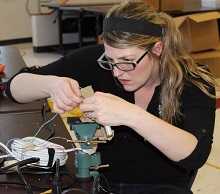One teacher describes the big impact robotics, coding, and STEM has had on her students

I love every aspect of programming—the frustration, the creativity, everything. I taught myself and now I’m lucky enough to teach students how to code, build robots, and design mobile apps. I’m there to guide them, but the students, like me, are really learning these skills through their own hard work.
I think everyone should learn how to program and of course I’m no exception. My transformation from librarian-turned-tech facilitator to coding teacher started with a back room full of old busted computers. My school didn’t know what to do with them so I decided to fix them up and make them useful. Then I started thinking, “What else can I do?” I read something about Arduino and soon I was tinkering with parts, building, and programming anything I could get my hands on. It became a hobby.
When I moved to Plaquemine High School, near Baton Rouge, our principal had just written a big grant for the Dow Corp. to create a STEM program featuring elective classes in robotics and game design for 9-12th graders. When we got it, he asked me to design the curriculum, attend trainings, and teach the courses. It was a dream come true. Now I get to help students develop the creativity, logic, critical thinking, and career skills they need for the future. Here are seven reasons why every school should consider doing the same.…Read More

